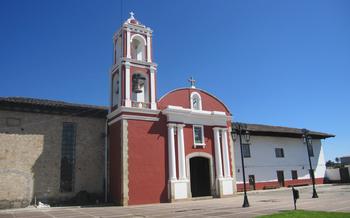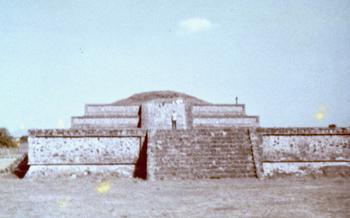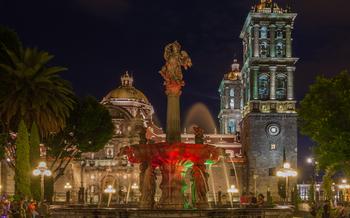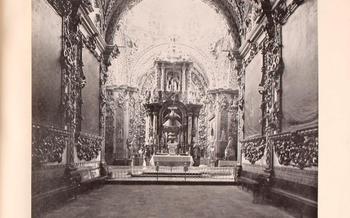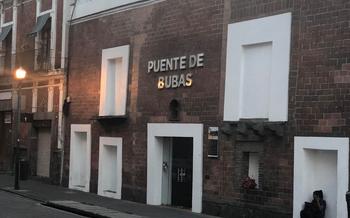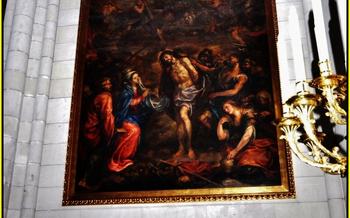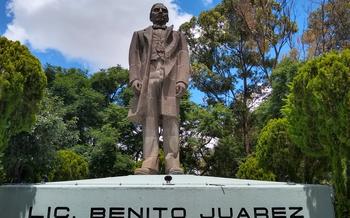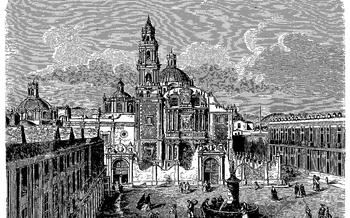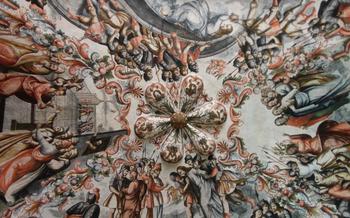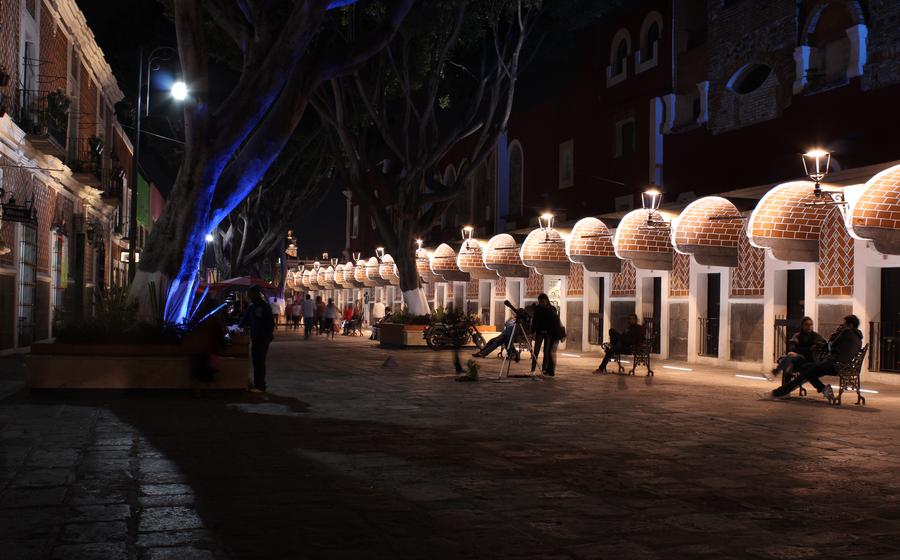
Barrio del Artista
- Plaza del Artista: The Heart of the Barrio
- Casa del Alfeñique: A Baroque Masterpiece
- Templo de San Francisco: A Spiritual and Architectural Gem
- Callejón de los Sapos: A Hidden Gem
- La Pasita: A Culinary Delight
- Casa de la Música de Viena: A Cultural Venue
- Capilla del Rosario: A Baroque Masterpiece
- Museo de la Talavera Poblana: A Celebration of Traditional Pottery
- Feria de Puebla: A Vibrant Cultural Festival
- Insider Tip: Hidden Gems
Plaza del Artista: The Heart of the Barrio
At the heart of the Barrio del Artista beats the Plaza del Artista, an iconic gathering spot and a stage for cultural events. This central plaza is a testament to Puebla's rich history and vibrant artistic spirit.
Surrounded by colorful buildings, the plaza showcases the neighborhood's architectural heritage. Historical landmarks, such as the 18th-century Fuente de los Sapos (Fountain of the Frogs), stand as silent witnesses to the passage of time. The plaza's centerpiece, a beautiful fountain adorned with intricate sculptures, adds a touch of elegance to the lively square.
The plaza is not just a physical space but a living entity, bustling with activity and creativity. Street performers entertain the crowds with music, dance, and acrobatics, creating a vibrant atmosphere that draws visitors and locals alike. Artisans display their handmade crafts, from intricate pottery to colorful textiles, transforming the plaza into a vibrant marketplace.
During the day, the plaza is a haven for relaxation and contemplation. Visitors can sit on benches beneath the shade of trees, enjoying the peaceful ambiance and the gentle murmur of the fountain. As evening falls, the plaza transforms into a lively venue for cultural events, hosting concerts, art exhibitions, and traditional dance performances.
In the Plaza del Artista, one can truly experience the essence of the Barrio del Artista, where art, culture, and community intertwine, creating a captivating tapestry of experiences.
Casa del Alfeñique: A Baroque Masterpiece
In the heart of Barrio del Artista stands Casa del Alfeñique, a captivating architectural gem that transports visitors back to the opulent era of Puebla's colonial past. Once the lavish residence of wealthy merchants, this iconic building is renowned for its intricate Baroque facade, a testament to the city's artistic heritage.
Delectable stuccowork adorns the exterior, showcasing a mesmerizing array of cherubs, flowers, and mythical creatures. The intricate carvings and delicate detailing are a testament to the skill and artistry of Puebla's master craftsmen. Step inside, and you'll be greeted by a grand courtyard, surrounded by elegant arches and columns. The building's interior is adorned with colorful tiles, frescoes, and intricate woodwork, creating a sense of grandeur and opulence.
Casa del Alfeñique has undergone a remarkable transformation, evolving from a private residence to a vibrant cultural center. Today, it houses art exhibitions, cultural events, and workshops, showcasing the diverse talents of local and international artists. Guided tours are available, providing visitors with insights into the building's history, architecture, and ongoing cultural significance.
Be sure to bring your camera to capture the exquisite beauty of Casa del Alfeñique. The intricate details and vibrant colors are a photographer's dream, making this a perfect spot to document your visit to Barrio del Artista.
Templo de San Francisco: A Spiritual and Architectural Gem
Standing tall amidst the testament to Puebla's rich colonial heritage and enduring faith. Constructed in the 16th century, this majestic church has witnessed centuries of history unfold within its sacred walls.
The Templo de San Francisco boasts an impressive architectural style that blends Gothic and Renaissance elements. Its façade, adorned with intricate carvings and sculptures, tells stories of biblical scenes and the lives of saints. The interior of the church is equally awe-inspiring, with its soaring arches, ornate altars, and stunning stained-glass windows that bathe the space in a kaleidoscope of colors.
Beyond its architectural beauty, the Templo de San Francisco holds deep religious significance for the people of Puebla. It is a place of worship, where locals gather for mass, prayer, and spiritual reflection. The church also plays a central role in local festivals and processions, becoming a focal point for the community's vibrant religious traditions.
Stepping inside the Templo de San Francisco is like stepping back in time. The atmosphere is one of reverence and tranquility, inviting visitors to pause and reflect on the spiritual essence of this sacred space. The scent of incense fills the air, and the soft glow of candlelight flickers against the intricate altarpieces, creating a sense of awe and wonder.
Whether you are a devout Catholic, a history buff, or simply someone who appreciates architectural masterpieces, the Templo de San Francisco is a must-visit destination in the Barrio del Artista. Its spiritual ambiance, historical significance, and stunning beauty make it a place that will leave a lasting impression on your soul.
Callejón de los Sapos: A Hidden Gem
Venturing into the Barrio del Artista, one stumbles upon a hidden gem that exudes charm and mystery: the Callejón de los Sapos, or Alley of the Toads. Legends and stories surround this narrow alleyway, weaving a tapestry of intrigue and enchantment.
The walls of the Callejón de los Sapos are adorned with vibrant murals and graffiti, creating a kaleidoscope of colors and artistic expression. These works of art tell tales of the neighborhood's history, its people, and their dreams.
Within the alleyway, small shops and cafes beckon visitors to step inside and explore the treasures they hold. Local artisans display their handcrafted goods, from intricate pottery to colorful textiles, offering a glimpse into the vibrant creative culture of Puebla.
As one wanders through the Callejón de los Sapos, the sense of discovery is palpable. Around every corner, a new sight or sound awaits, inviting visitors to immerse themselves in the neighborhood's unique atmosphere.
In the heart of the alleyway stands a centuries-old fountain, a reminder of the neighborhood's rich history. Locals gather here to share stories, exchange laughter, and bask in the warmth of community.
The Callejón de los Sapos is more than just an alleyway; it's a living, breathing testament to the creativity and spirit of the Barrio del Artista. It's a place where art, history, and culture converge, creating an unforgettable experience for those who dare to explore its hidden depths.
La Pasita: A Culinary Delight
La Pasita is a traditional Mexican dish that holds a special place in the culinary heritage of Puebla. This savory dish, made from dried fruit and meat, is a testament to the region's rich culinary traditions.
La Pasita is prepared using a unique combination of ingredients, including dried fruit such as raisins, apricots, and peaches, along with pork or beef. The dried fruit is soaked and then simmered in a flavorful broth, often made with spices and herbs like cinnamon, cloves, and bay leaves. The meat is added and cooked until tender, infusing the broth with its rich flavors.
This dish is often served as a main course and is typically accompanied by rice or beans. The sweet and tangy flavors of the dried fruit, combined with the savory taste of the meat, create a harmonious balance of flavors that is sure to tantalize your taste buds.
La Pasita holds cultural significance in Puebla, often associated with celebrations and festivities. It is a dish that brings families and friends together, adding a touch of warmth and tradition to special occasions.
If you're looking to experience the authentic flavors of Puebla, be sure to try La Pasita. This culinary delight can be found in many traditional restaurants and markets throughout the Barrio del Artista. Ask the locals for their recommendations, and you'll be sure to find the best La Pasita in town.
Casa de la Música de Viena: A Cultural Venue
Nestled within the vibrant Barrio del Artista, the Casa de la Música de Viena stands as a testament to Puebla's rich cultural heritage. Originally a private residence, this historic building has been transformed into a vibrant cultural center, hosting a diverse range of events and performances that captivate visitors and locals alike.
The Casa de la Música de Viena's architectural grandeur reflects its storied past. Its elegant facade, adorned with intricate carvings and wrought-iron balconies, hints at the building's former opulence. Inside, visitors are greeted by a spacious courtyard, where the gentle sound of classical music fills the air, creating an atmosphere of tranquility and inspiration.
The cultural offerings at the Casa de la Música de Viena are as diverse as the city itself. From intimate concerts featuring local musicians to grand performances by international artists, the venue's stage has witnessed countless memorable moments. Classical music enthusiasts can indulge in the sweet melodies of a string quartet, while contemporary art lovers can immerse themselves in cutting-edge dance performances or thought-provoking theater productions.
Attending an event at the Casa de la Música de Viena is an experience that transcends the ordinary. The venue's intimate setting and exceptional acoustics create a sense of closeness between performers and audience, fostering a genuine connection that transforms each performance into a truly special occasion.
Whether you're a seasoned music aficionado or simply seeking a unique cultural experience, the Casa de la Música de Viena promises an unforgettable evening. As the curtains rise and the music begins to play, prepare to be captivated by the magic that unfolds within this historic venue.
Capilla del Rosario: A Baroque Masterpiece
Deep within the heart of Puebla's historic center, nestled among colonial buildings and vibrant streets, lies a hidden gem that embodies the essence of Baroque artistry: the Capilla del Rosario. Constructed in the 17th century, this chapel stands as a testament to the city's rich cultural heritage and enduring faith.
As you step through the unassuming entrance, prepare to be awestruck by the lavish interior that unfolds before your eyes. Every inch of the chapel is adorned with intricate Churrigueresque ornamentation, creating a visual symphony of swirling patterns, gilded surfaces, and delicate sculptures. The walls, ceiling, and altar are a testament to the skill and artistry of the craftsmen who dedicated their lives to this sacred space.
The centerpiece of the chapel is its magnificent altarpiece, a masterpiece of Baroque excess. Towering over the sanctuary, it is a riot of color, gold leaf, and intricate carvings depicting scenes from the life of Christ and the Virgin Mary. The attention to detail is simply breathtaking, with each figure, each fold of drapery, and each architectural element meticulously rendered.
Beyond its aesthetic beauty, the Capilla del Rosario holds deep religious significance for the people of Puebla. It serves as a place of worship, a site of pilgrimage, and a symbol of faith. Throughout the year, the chapel hosts religious festivals, processions, and special masses, drawing devotees from all corners of the city.
To truly appreciate the magic of the Capilla del Rosario, it is best to visit during one of these special occasions. Immerse yourself in the vibrant atmosphere, the melodious chants, and the fervent prayers that fill the air. Witness the deep devotion of the faithful as they seek solace, guidance, and blessings within these sacred walls.
Whether you are a devout pilgrim, an art enthusiast, or simply a curious traveler, the Capilla del Rosario is a must-visit destination in Puebla. Let its Baroque splendor transport you to another era, where faith, art, and history intertwine to create a truly awe-inspiring experience.
Museo de la Talavera Poblana: A Celebration of Traditional Pottery
Nestled in the heart of the Barrio del Artista, the Museo de la Talavera Poblana stands as a testament to the rich tradition of Talavera pottery, an art form deeply embedded in the cultural heritage of Puebla. Established in 1992, the museum is dedicated to preserving, showcasing, and promoting this exquisite craft that has earned international recognition for its intricate designs and vibrant colors.
As you step into the museum, you are greeted by a captivating display of Talavera pottery pieces, each one a masterpiece of craftsmanship. The collection boasts a diverse range of objects, from decorative tiles and plates to vases, fountains, and sculptures, showcasing the versatility and artistry of this traditional art form.
The museum's exhibits take you on a journey through the history of Talavera pottery, from its origins in the 16th century to its evolution over the centuries. You will learn about the unique techniques and processes involved in creating these beautiful pieces, from the selection of clay and the intricate painting process to the final firing in kilns.
One of the highlights of the museum is the opportunity to witness skilled artisans at work, demonstrating their mastery of the craft. You can observe them carefully applying intricate designs, using a palette of vibrant colors, and bringing these works of art to life.
The Museo de la Talavera Poblana is not merely a repository of pottery; it is a vibrant center for cultural preservation and education. The museum regularly hosts workshops, demonstrations, and exhibitions, providing visitors with an immersive experience and a deeper understanding of this traditional art form.
Whether you are an art enthusiast, a history buff, or simply someone who appreciates the beauty of handmade crafts, a visit to the Museo de la Talavera Poblana is an enriching and unforgettable experience. It allows you to delve into the heart of Puebla's cultural heritage and witness firsthand the artistry and dedication that goes into creating these stunning works of art.
Feria de Puebla: A Vibrant Cultural Festival
The Feria de Puebla, held annually in April or May, is a vibrant and colorful celebration that showcases the rich cultural heritage of the city. This grand festival, also known as the Feria de San Francisco, attracts thousands of visitors from all over Mexico and beyond.
The Feria de Puebla is a time of great joy and revelry, with the streets of the city transformed into a sea of color and music. Elaborate parades featuring traditional costumes, giant puppets, and marching bands fill the air with excitement and laughter. Traditional dances, such as the Danza de los Voladores (Flying Pole Dance), and live music performances add to the festive atmosphere.
In addition to the parades and performances, the Feria de Puebla offers a wide range of activities and events for visitors to enjoy. There are traditional amusement rides, games, and food stalls, as well as cultural exhibitions, workshops, and conferences. The festival also features a large livestock fair, showcasing the region's agricultural heritage.
One of the highlights of the Feria de Puebla is the Coronación de la Reina (Coronation of the Queen), a prestigious event where a young woman is chosen to represent the city and preside over the festival's festivities. The coronation ceremony is a grand spectacle, filled with music, dance, and fireworks.
The Feria de Puebla is a unique opportunity to experience the vibrant culture and traditions of this historic city. Whether you're interested in admiring the colorful parades, enjoying the live performances, or simply soaking up the festive atmosphere, this festival is sure to leave you with lasting memories.
Insider Tip: Hidden Gems
Beyond the main attractions, Barrio del Artista holds hidden gems waiting to be discovered. For an authentic culinary experience, venture to Fonda La Mexicana, a family-run eatery serving traditional Poblano dishes in a cozy atmosphere. For a unique shopping experience, explore the local artisan market, Mercado de Artesanías, where you can find handmade crafts, textiles, and pottery. To delve deeper into the neighborhood's history, visit the Centro Cultural La Casa del Mendrugo, a cultural center housed in a restored 18th-century building, showcasing local art exhibitions and workshops. Embrace the vibrant street art scene by participating in a guided graffiti tour, offering insights into the neighborhood's urban art culture. Uncover the true essence of Barrio del Artista by venturing beyond the main tourist spots and immersing yourself in its hidden treasures.
